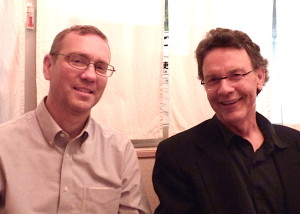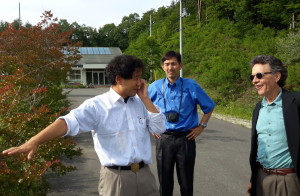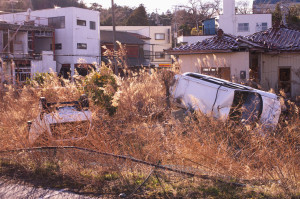Colorado State University and Fukushima University are together hiring a world-renowned radioecology expert to help study the environmental effects of radioactive releases after a nuclear meltdown at the Fukushima Daiichi Nuclear Power Plant in spring 2011.
Thomas Hinton, a CSU alumnus, is coordinator of the STAR Network of Excellence in Radioecology and deputy director of the Department of Environmental Risks at the French Institut de Radioprotection et de Sûreté Nucléaire, an authority on nuclear and radiation risks. He joined Fukushima University’s Institute of Environmental Radioactivity (IER) on March 1.

Colorado State is co-sponsoring Hinton’s salary in an arrangement expected to benefit both universities and their students: Fukushima will draw on CSU’s expertise in the Department of Environmental and Radiological Health Sciences, while CSU faculty and students will gain rare access to the site of a nuclear disaster to study its effects.
The hire is the newest outgrowth of partnerships the CSU College of Veterinary Medicine and Biomedical Sciences has established with Japanese universities and agencies to study radiation and its implications for human, animal and environmental health.
‘Groundbreaking’
“This is really groundbreaking,” said Jac Nickoloff, head of the ERHS department at CSU. “Tom Hinton is one of the most knowledgeable people in the world about this field. You couldn’t find a better person to lead this project. There aren’t many opportunities to study this sort of thing.”
An earthquake and tsunami struck Japan in March 2011, causing the nuclear accident; there have been no reported deaths or illnesses resulting from radiation, yet more than 100,000 people remain evacuated from the region because of concerns about radioactivity.
“We are thrilled to be partnering with CSU to bring a distinguished scientist like Thomas Hinton to our joint research efforts,” said IER Director Takayuki Takahashi. “Our Institute of Environmental Radioactivity will benefit immensely from the expertise that he and CSU’s Department of Environmental and Radiological Health Sciences bring. And we look forward to sharing what we learn about radiation from the 2011 disaster.”

Hinton examines how radiation affects wildlife and the environment. He has studied, for instance, the impact of the Chernobyl nuclear disaster on gray wolves.
Hinton said he hopes to help build a world-class radioecology group with Fukushima University and CSU – allowing for far better understanding of radiation in Japan.
CSU mentors
He is also eager to enhance radioecology research at CSU, where he learned from two faculty pioneers: Ward Whicker and John Pinder.
“They are two of the finest scientists with whom I have ever had the pleasure to work,” Hinton said. “My life has indeed been enriched because of their mentoring and close friendships. I am thrilled to take their lessons and attempt to apply them in Japan.”
Whicker is a professor emeritus who mentored Hinton while he earned his master’s degree and Ph.D. Whicker called his former student “the best trained, truly international scientist in the environmental radiation field.”
Through partnerships in Japan, Colorado State has strengthened its radiological sciences programs: The university recently announced it is working with the National Institute of Radiological Sciences in Japan to build a carbon-ion radiotherapy facility in Aurora. The cancer research and treatment center would be the first of its kind in the United States.
Student visits
CSU students regularly visit Fukushima as part of a radiation studies exchange program launched in 2014, and students there likewise travel to Colorado State. As a joint faculty member, Hinton will help boost these opportunities.

“It’s a great way for our students to learn and for us to do research in a groundbreaking area,” said Thomas Johnson, head of CSU’s Health Physics Program. “It’s a living laboratory. Tom Hinton knows what expertise we have, and he will bridge CSU and Fukushima University. So when he sees things we can help with, he’s there on the spot. When he sees the opportunities, he can send our students there or send their students here. And we’ve started applying for grants that wouldn’t be possible without having Dr. Hinton there.”
Whicker added, “It will give us a really good link, and will give young scientists and students an amazing way to learn about the science from us. It’s a cultural exchange as well as a scientific exchange.”
Johnson said he expects at least two CSU graduate students to visit Japan each year to do research that would not be possible without Hinton.
Animal studies
Hinton said he plans to study a variety of wild animals living around the Fukushima Daiichi Nuclear Power Plant, employing a tool he recently developed in France that can send an animal’s location and radiation exposure levels to researchers via satellite, helping them assess the animals’ responses to radiation. Study of Japanese snow monkeys, for instance, will provide insights about the health of that species and about the effects of radiation on another primate species – humans.
Nickoloff said the research is also expected to inform ongoing discussions about risks of chronic radiation exposures, which help determine how much clean-up is necessary after nuclear disasters and at former nuclear facilities such as Rocky Flats in Colorado. In addition, it will provide the Japanese with an independent assessment of an issue that remains controversial: To what extent is the leaked radiation from the nuclear plant a health threat?
“This gives them an impartial third party who they can trust,” said Whicker, who plans to visit his protégé in Japan in May.
“Perhaps no other country is in greater need of unbiased understanding of environmental radiation,” Hinton said. “I will go to Japan humbled by the horrific experiences of the people living in Fukushima, and with hope that my knowledge can be used to their benefit.”